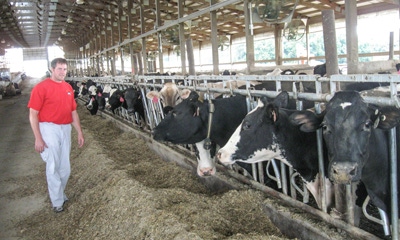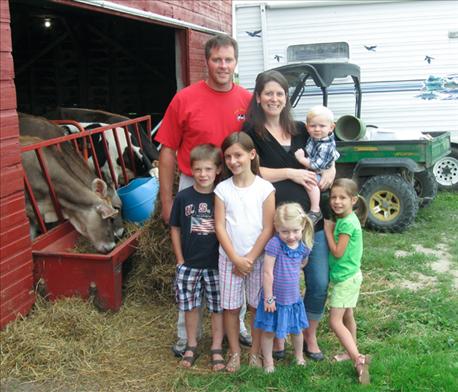September 27, 2016

Dairy farmer Joe Loehr was honored this year by not just one, but two national breed organizations. He milks 450 cows with two brothers, and a herd expansion is underway. Joe was recognized as Distinguished Young Holstein Breeder by the National Holstein Association and as Outstanding Young Brown Swiss Breeder by the National Brown Swiss Association at their respective annual meetings.

DAIRY EXPANSION: A huge 236-by-116-foot addition to the existing freestall barn was just completed and is allowing Joe Loehr and his family to expand their milking herd.
"It was a surprise," he says of his selection. He explains that both awards came about after an application process open to breeders 40 years of age and younger. Since he's in his last year of eligibility, he decided to try. It was the first time he had applied for either of the two awards. And with pride for his family, Joe says the honors are the result of a "team effort. It's not something that can be done alone." He farms with two brothers, Dan and Mark, at Loehr Dairy LLC. A deeply religious man who is active in his church and has his children in parochial school, Joe adds that the awards are "blessings from God. As farmers, we always feel like we are working with God. We are nothing without him."
Farm progress
The application forms for the two awards, Joe points out, ask about the history and progress of the farm, now in its fourth generation of family ownership near Mount Calvary in Fond du Lac County, and also about management practices and future goals. The 800-acre farm, with 650 acres family-owned, became a Wisconsin Century Farm in 1980. A just-completed barn addition is allowing for a 60-cow expansion.

FAMILY FARM: Joe and his wife, Gina, (holding youngest child Anthony) and their children are the fourth and fifth generations to live and farm on the Loehr family farm. Their kids are: (from left) Isaac, Sophia, Gianna and Lucia.
"We saw significant accomplishment in the last two to three years," says Joe, who serves as spokesman for Loehr Dairy. "In the 22 years I've been managing, the dairy has improved 10,000 pounds of milk per cow, from 17,000 to 27,000. To do that, we improved facilities, feed quality and the care we give to the herd. ... Also, the genetic improvement has been substantial. We've been able in the last two years to have a Holstein bull and heifer reach the top 20 in the world in genetic Total Performance Index." Several Brown Swiss in the herd also have achieved that level, he adds.
"The opportunity to be able to do DNA testing began in 2009, and I jumped in head first," Joe continues, "and it's been very beneficial in terms of genetic progress. We look for a strong emphasis on component percentages in milk, especially percentage of protein. We really want a well-balanced cow: not too big, not too small, easy to take care of, healthy, easy to impregnate and with excellent longevity. The balance includes everything." The brothers are proud enough of their cattle to enter two young Brown Swiss heifers at this year's World Dairy Expo.
Until the barn addition was completed, they were milking 250 registered Holsteins, 35 registered Brown Swiss and 155 crosses of the two breeds. The crossbreds "are not our genetically elite cows, but are very competitive productively," Joe says. The brothers also have experimented with Jersey and Normandy crosses, but moved away from them to stay with the higher milk production from Holstein and Swiss genetics. Joe makes the mating decisions and does most of the inseminating with a variety of semen kept on hand. Dan and one of the farm's eight employees also help with the AI work.
Cows are milked three times daily in a swing-12 parlor and currently have a 4% butterfat and 3.35% protein test with a somatic cell count of 119. Milk goes to Baker Cheese in nearby St. Cloud.
A 236-by-116-foot addition to the existing freestall barn was just completed and is allowing Loehr Dairy to expand the milking herd, all from the brothers' own replacement stock. They also will move dry cows over from another barn.
"So the entire herd will be under one roof," says Joe. Calves and heifers for replacement stock are all raised on the farm. Culling turns over about 30% of the herd each year.
The addition was constructed by the same Amish builders who put up the original freestall barn several years ago. Joe says the family was pleased with the quality of work on the initial construction. The new barn is located behind an original stanchion barn on the farm where the brothers and their siblings grew up. Mark and his wife and child still occupy the original farmhouse. Other family members, sisters, brothers, their father, Norman Loehr, and nieces and nephews help out on the farm.
Continuous communication
Joe says he, Dan and Mark try to meet weekly to plan their workload and come together often on a daily basis. They get along well, he asserts.
"We try to come to an agreement; we try to come to an understanding on what's best for the farm, the business. We try to maintain a healthy respect for each other; that's necessary in any business. Certainly it's even better with family."
Joe and his wife, Gina, live on the farm with their five children: Sophia, 8, Isaac, 6, Lucia, 5, Gianna, 3, and Anthony, 1. Another baby is on the way. Dan's wife is Grace, and they live outside Fond du Lac with two children, Calla, 15, and Brady, 13. Mark and his wife, Tina, have a daughter, Molly, 2.
The brothers are all graduates of Campbellsport High School. Dan, the oldest, attended University of Wisconsin Farm and Industry Short Course. Mark went through four years of college, while Joe went into full-time farming right out of high school. They grow corn, alfalfa, soybeans and wheat.
"We try to do at least 300 acres of winter rye as a cover crop and a spring forage," Joe says. Eventually he would like to see "something growing on all the land all year-round — cover crops." Alfalfa and corn are harvested into bunker silos. Some soybeans and wheat are sold for grain, while corn for grain is purchased. The cattle are fed a total mixed ration.
Milking cows are bedded with sand. Heifers have a combination of bedded pack or freestall buildings. Calves are raised in hutches. In the new barn addition, dry cows are housed on a combination of sand-bedded freestalls and composted sawdust packs over an earth base. The barn has a gravity-flow manure handling system.
There are no more plans to increase the herd size, Joe says.
"We'd like to improve what we do in each aspect of the business, whether it's more crop yield, more efficient production and increasing the pounds of milk sold."
Buchholz writes from Fond du Lac.
You May Also Like




